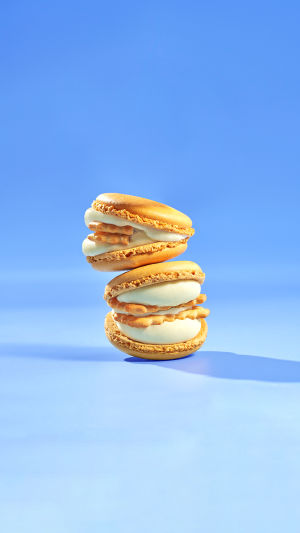The macaron, a quintessential French dessert, consists of egg whites, almond flour, granulated sugar, and powdered sugar, with layers of fruit jam or cream sandwiched in between.
It boasts a rich texture, crisp exterior, and soft interior, while its appearance is vibrant and delicate.
Although macarons are widely associated with French cuisine, they were actually invented by the Italians. The specific origin of macarons is subject to various accounts.
One version tells the story of Catherine de' Medici, a noble from Florence, who married King Henry II of France in the mid-16th century. Despite her royal status, Catherine suffered from homesickness after moving to France. To win her favor, the chefs who accompanied her to France prepared macarons from her homeland. This Italian-style dessert thus gained popularity in France.
Originally, when introduced in France, macarons were single-layered and unfilled, differing significantly from the modern version. However, as the almond meringue cookies spread throughout France, especially in the 19th century, French chefs began experimenting with fillings, incorporating various fruits, jams, and even coffee and chocolate to create a colorful array of flavors. Thus, the almond cookies evolved into the macarons known in the 21st century.
Macarons, which were once a food of the nobility and a symbol of luxury, gradually became accessible to ordinary people. With their colorful appearance, fresh and delicate texture, and petite size, macarons gained widespread popularity.
Macarons are characterized by distinct layers. When you take a bite, you first taste the thin but crunchy shell, followed by the soft and creamy filling made with butter. The almond cookie provides structure to the filling while adding chewiness.
A perfect macaron is smooth on the surface, without blemishes, and emits a subtle sheen under light. The bottom edge of the cookie often features a ring of decorative materials such as matcha powder or fruit powder, adding to its colorful appearance.
The process of making macaron shells typically involves 75 grams of granulated sugar and 90 grams of powdered sugar, with an additional 60 grams of granulated sugar added during the filling preparation. Consequently, some people find macarons too sweet.
<b>French method:</b>
1. Begin by mixing almond flour and powdered sugar, then processing the mixture in a food processor for about two minutes.
2. Beat egg whites with a whisk until they form coarse bubbles, then add granulated sugar and continue beating.
3. While beating, add a small amount of food coloring to give the egg whites a vibrant color.
4. Continue beating until the egg whites reach stiff peaks (when you lift the whisk, the egg whites form a stiff peak).
5. Fold the almond flour and powdered sugar mixture into the whipped egg whites.
6. Use a rubber spatula to gently fold from the bottom up until the mixture is evenly combined.
7. Keep folding until the batter reaches the desired consistency: when you lift the spatula, the batter should fall in a ribbon-like manner.
8. Transfer the batter to a piping bag fitted with a small round tip and pipe circles of batter about 3cm in diameter onto a silicone mat.
9. After piping the batter, allow it to air dry in a ventilated area for about half an hour until the surface is no longer sticky and forms a firm shell.
10. Preheat the oven. Bake at 165 degrees Celsius for 14 minutes on the middle rack. After about 6-8 minutes in the oven, the macarons will develop their characteristic 'feet,' the frilly edges at the base. Once cooled, use a small spatula to remove the macarons from the mat.
11. Once the macaron shells have cooled, you can sandwich them with filling. However, they should not be eaten immediately as the filling and shells are still separate.
12. Allow the macarons to mature, absorbing moisture until the exterior becomes crispy and the interior softens, blending the aroma of almond flour with the flavor of the filling, before serving.
From the nobility's palaces to the tables of ordinary people, the story of macarons carries the transitions of history and people's aspirations for a better life. In every bite of a macaron, there lies the chef's craftsmanship and pursuit of excellence. Let us continue to savor the sweetness and charm with reverence for food, praising the sophistication and culture represented by macarons.





